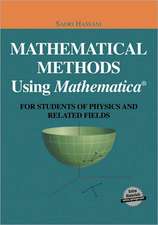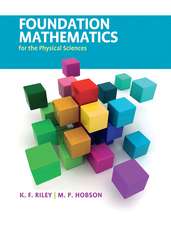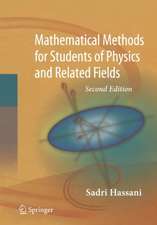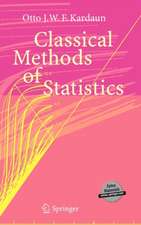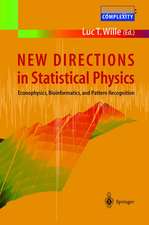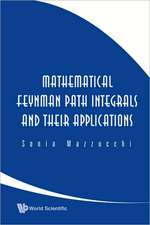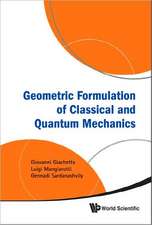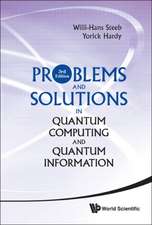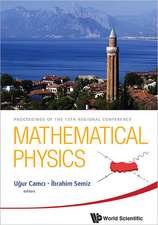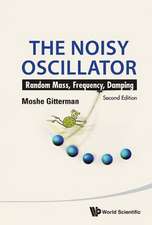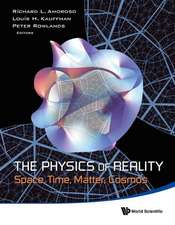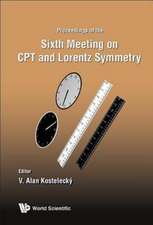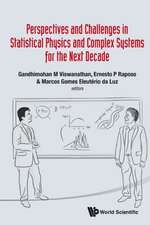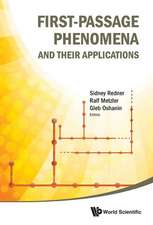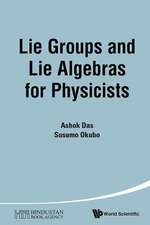Mathematical Physics: A Modern Introduction to Its Foundations
Autor Sadri Hassanien Limba Engleză Hardback – 19 aug 2013
This second edition is a substantial revision with a complete rewriting of many chapters and the addition of new ones, including chapters on algebras, representation of Clifford algebras, fibre bundles, and gauge theories. The spirit of the first edition, namely the balance between rigour and physical application, has been maintained, as is the abundance of historical notes and worked out examples that demonstrate the "unreasonable effectiveness of mathematics" in modern physics.
Preț: 508.47 lei
Preț vechi: 612.62 lei
-17% Nou
Puncte Express: 763
Preț estimativ în valută:
97.29€ • 101.86$ • 80.51£
97.29€ • 101.86$ • 80.51£
Carte disponibilă
Livrare economică 17-31 martie
Livrare express 28 februarie-06 martie pentru 93.16 lei
Preluare comenzi: 021 569.72.76
Specificații
ISBN-13: 9783319011943
ISBN-10: 3319011944
Pagini: 1025
Ilustrații: XXXI, 1205 p. 160 illus.
Dimensiuni: 178 x 254 x 71 mm
Greutate: 2.16 kg
Ediția:2nd ed. 2013
Editura: Springer International Publishing
Colecția Springer
Locul publicării:Cham, Switzerland
ISBN-10: 3319011944
Pagini: 1025
Ilustrații: XXXI, 1205 p. 160 illus.
Dimensiuni: 178 x 254 x 71 mm
Greutate: 2.16 kg
Ediția:2nd ed. 2013
Editura: Springer International Publishing
Colecția Springer
Locul publicării:Cham, Switzerland
Public țintă
GraduateCuprins
Mathematical Preliminaries.- I Finite-Dimensional Vector Spaces.- 1 Vectors and Linear Maps.- 2 Algebras.- 3 Operator Algebra.- 4 Matrices.- 5 Spectral Decomposition.- II Infinite-Dimensional Vector Spaces.- 6 Hilbert Spaces.- 7 Classical Orthogonal Polynomials.- 8 Fourier Analysis.- III Complex Analysis.- 9 Complex Calculus.- 10 Calculus of Residues.- 11 Advanced Topics.- IV Differential Equations.- 12 Separation of Variables in Spherical Coordinates.- 13 Second-Order Linear Differential Equations.- 14 Complex Analysis of SOLDEs.- 15 Integral Transforms and Differential Equations.- V Operators on Hilbert Spaces.- 16 Introductory Operator Theory.- 17 Integral Equations.- 18 Sturm-Liouville Systems.- VI Green's Functions.- 19 Green's Functions in One Dimension.- 20 Multidimensional Green's Functions: Formalism.- 21 Multidimensional Green's Functions: Applications.- VII Groups and Their Representations.- 22 Group Theory.- 23 Representation of Groups.- 24 Representations of the Symmetric Group.- VIII Tensors and Manifolds.- 25 Tensors.- 26 Clifford Algebras.- 27 Analysis of Tensors.- IX Lie Groups and Their Applications.- 28 Lie Groups and Lie Algebras.- 28.2 An Outline of Lie Algebra Theory.- 29 Representation of Lie Groups and Lie Algebras.- 30 Representation of Clifford Algebras.- 31 Lie Groups and Differential Equations.- 32 Calculus of Variations, Symmetries, and Conservation Laws.- X Fiber Bundles.- 33 Fiber Bundles and Connections.- 34 Gauge Theories.- 35 Differential Geometry.- 36 Riemannian Geometry.
Recenzii
From the book reviews:
“Mathematical Physics: A Modern Introduction to Its Foundations is intended for adoption in a course or a sequence of ‘methods of mathematical physics’ at the advanced undergraduate or beginning graduate level. … this is a textbook that every library must have (with a large number of copies in reserve), and it will be a valuable aid for committed students, researchers, and instructors of science and applied mathematics.” (Eleftherios Kirkinis, SIAM Review, Vol. 56 (3), September, 2014)
“Hassani uses the concept of a vector space to build all of the discussions for the basic ideas about the subject. … Hassani writes well and does a very good job of connecting the various topics presented. Each of the 30 chapters contains clear, worked-out examples and problems at the end. Summing Up: Recommended. Upper-division undergraduates and graduate students.” (E. Kincanon, Choice, Vol. 51 (11), July, 2014)
Some praise for the previous edition:
PAGEOPH [Pure and Applied Geophysics]
Review by Daniel Wojcik, University of Maryland
"This volume should be a welcome addition to any collection. The book is well written and explanations are usually clear. Lives of famous mathematicians and physicists are scattered within the book. They are quite extended, often amusing, making nice interludes. Numerous exercises help the student practice the methods introduced. … I have recently been using this book for an extended time and acquired a liking for it. Among all the available books treating mathematical methods of physics this one certainly stands out and assuredly it would suit the needs of many physics readers."
ZENTRALBLATT MATH
Review by G.Roepstorff, University of Aachen, Germany
"… Unlike most existing texts with the same emphasis and audience, which are merely collections of facts and formulas, the present book is more systematic, self-contained, with a level of presentation that tends to be more formal and abstract. This entails proving a large number of theorems, lemmas, and corollaries, deferring most of the applications that physics students might be interested in to the example sections in small print. Indeed, there are 350 worked-out examples and about 850 problems. … A very nice feature is the way the author intertwines the formalism with the life stories and anecdotes of some mathematicians and physicists, leading at their times. As is often the case, the historical view point helps to understand and appreciate the ideas presented in the text. … For the physics student in the middle of his training, it will certainly prove to be extremely useful."
THE PHYSICIST
Review by Paul Davies, Orion Productions, Adelaide, Australia
"I am pleased to have so many topics collected in a single volume. All the tricks are there of course, but supported by sufficient rigour and substantiation to make the dedicated mathematical physicist sigh with delight."
EMS [EUROPEAN MATHEMATICAL SOCIETY] NEWSLETTER
"This book is a condensed exposition of the mathematics that is met in most parts of physics. The presentation attains a very good balance between the formal introduction of concepts, theorems and proofs on one hand, and the applied approach on the other, with many examples, fully or partially solved problems, and historical remarks. An impressive amount of mathematics is covered. … This book can be warmly recommended as a basic source for the study of mathematics for advanced undergraduates or beginning graduate students in physics and applied mathematics, and also as a reference book for all working mathematicians and physicists."
“Mathematical Physics: A Modern Introduction to Its Foundations is intended for adoption in a course or a sequence of ‘methods of mathematical physics’ at the advanced undergraduate or beginning graduate level. … this is a textbook that every library must have (with a large number of copies in reserve), and it will be a valuable aid for committed students, researchers, and instructors of science and applied mathematics.” (Eleftherios Kirkinis, SIAM Review, Vol. 56 (3), September, 2014)
“Hassani uses the concept of a vector space to build all of the discussions for the basic ideas about the subject. … Hassani writes well and does a very good job of connecting the various topics presented. Each of the 30 chapters contains clear, worked-out examples and problems at the end. Summing Up: Recommended. Upper-division undergraduates and graduate students.” (E. Kincanon, Choice, Vol. 51 (11), July, 2014)
Some praise for the previous edition:
PAGEOPH [Pure and Applied Geophysics]
Review by Daniel Wojcik, University of Maryland
"This volume should be a welcome addition to any collection. The book is well written and explanations are usually clear. Lives of famous mathematicians and physicists are scattered within the book. They are quite extended, often amusing, making nice interludes. Numerous exercises help the student practice the methods introduced. … I have recently been using this book for an extended time and acquired a liking for it. Among all the available books treating mathematical methods of physics this one certainly stands out and assuredly it would suit the needs of many physics readers."
ZENTRALBLATT MATH
Review by G.Roepstorff, University of Aachen, Germany
"… Unlike most existing texts with the same emphasis and audience, which are merely collections of facts and formulas, the present book is more systematic, self-contained, with a level of presentation that tends to be more formal and abstract. This entails proving a large number of theorems, lemmas, and corollaries, deferring most of the applications that physics students might be interested in to the example sections in small print. Indeed, there are 350 worked-out examples and about 850 problems. … A very nice feature is the way the author intertwines the formalism with the life stories and anecdotes of some mathematicians and physicists, leading at their times. As is often the case, the historical view point helps to understand and appreciate the ideas presented in the text. … For the physics student in the middle of his training, it will certainly prove to be extremely useful."
THE PHYSICIST
Review by Paul Davies, Orion Productions, Adelaide, Australia
"I am pleased to have so many topics collected in a single volume. All the tricks are there of course, but supported by sufficient rigour and substantiation to make the dedicated mathematical physicist sigh with delight."
EMS [EUROPEAN MATHEMATICAL SOCIETY] NEWSLETTER
"This book is a condensed exposition of the mathematics that is met in most parts of physics. The presentation attains a very good balance between the formal introduction of concepts, theorems and proofs on one hand, and the applied approach on the other, with many examples, fully or partially solved problems, and historical remarks. An impressive amount of mathematics is covered. … This book can be warmly recommended as a basic source for the study of mathematics for advanced undergraduates or beginning graduate students in physics and applied mathematics, and also as a reference book for all working mathematicians and physicists."
Notă biografică
Sadri Hassani is Professor Emeritus in the Department of Physics at Illinois State University, USA.
Textul de pe ultima copertă
The goal of this book is to expose the reader to the indispensable role that mathematics---often very abstract---plays in modern physics. Starting with the notion of vector spaces, the first half of the book develops topics as diverse as algebras, classical orthogonal polynomials, Fourier analysis, complex analysis, differential and integral equations, operator theory, and multi-dimensional Green's functions. The second half of the book introduces groups, manifolds, Lie groups and their representations, Clifford algebras and their representations, and fiber bundles and their applications to differential geometry and gauge theories.
This second edition is a substantial revision of the first one with a complete rewriting of many chapters and the addition of new ones, including chapters on algebras, representation of Clifford algebras and spinors, fiber bundles, and gauge theories. The spirit of the first edition, namely the balance between rigor and physical application, has been maintained, as is the abundance of historical notes and worked out examples that demonstrate the "unreasonable effectiveness of mathematics" in modern physics.
Einstein has famously said, "The most incomprehensible thing about nature is that it is comprehensible." What he had in mind was reiterated in another one of his famous quotes concerning the question of how " ... mathematics, being after all a product of human thought, is so admirably appropriate to the objects of reality." It is a question that comes to everyone's mind when encountering the highly abstract mathematics required for a deep understanding of modern physics. It is the experience that Eugene Wigner so profoundly described as "the unreasonable effectiveness of mathematics in the natural sciences."
This second edition is a substantial revision of the first one with a complete rewriting of many chapters and the addition of new ones, including chapters on algebras, representation of Clifford algebras and spinors, fiber bundles, and gauge theories. The spirit of the first edition, namely the balance between rigor and physical application, has been maintained, as is the abundance of historical notes and worked out examples that demonstrate the "unreasonable effectiveness of mathematics" in modern physics.
Einstein has famously said, "The most incomprehensible thing about nature is that it is comprehensible." What he had in mind was reiterated in another one of his famous quotes concerning the question of how " ... mathematics, being after all a product of human thought, is so admirably appropriate to the objects of reality." It is a question that comes to everyone's mind when encountering the highly abstract mathematics required for a deep understanding of modern physics. It is the experience that Eugene Wigner so profoundly described as "the unreasonable effectiveness of mathematics in the natural sciences."
Caracteristici
Appreciated for its balance between rigor and physical application New chapters on algebras, representation of Clifford algebras and spinors, fiber bundles, and gauge theories Includes historical notes and over 900 worked-out examples. Includes supplementary material: sn.pub/extras

